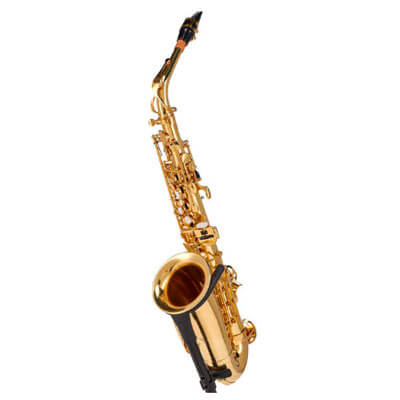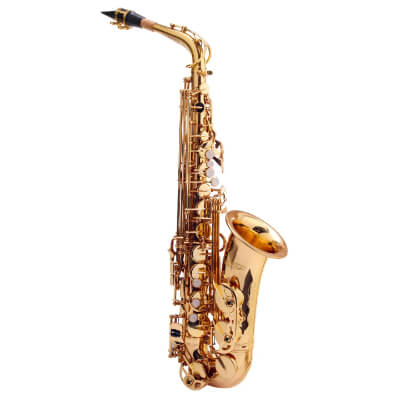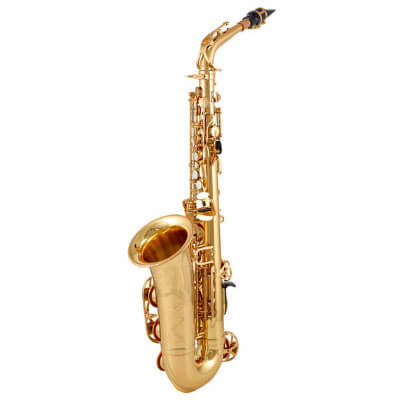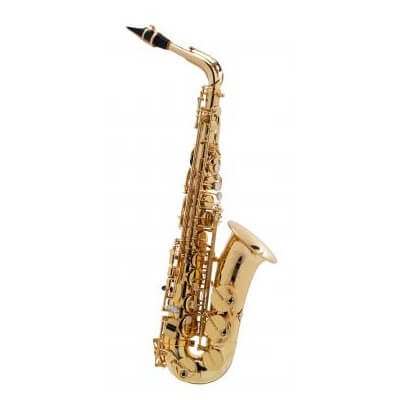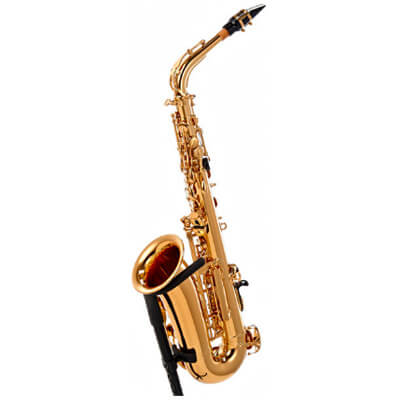Buying a saxophone: My 7 best recommendations 2025
Here you will find the best saxophones for beginners, advanced players and children. I have answered the frequently asked questions below about what you should look for when buying a saxophone.
This text has been translated into English. Please report spelling mistakes to sebastian@musiksocke.com
What kind of saxophone are you looking for?
Frequently asked questions:
Saxophone for beginners
Beginners are best advised to choose an alto saxophone from lesser-known brands. A robust construction, smooth action and a good volume of sound are important. An easy response is just as important for the start, so that playing is fun and does not lead to moments of frustration. This is already offered by some models from Startone, Classic Cantabile and Cherrystone, which are in the lower price range. For the beginning, I recommend the following saxophones. After the initial period, they can be improved with higher quality mouthpieces and reeds.
The Startone SAS-75 alto saxophone is a saxophone for beginners with a good price-performance ratio. The set includes a case, strap, mouthpiece and matching reeds. With this, you can start right away. The saxophone is surprisingly good for this price and has a flawless mechanism. The included mouthpiece and reeds fit the saxophone perfectly and has an easy response. The strap, however, has been skimped on. It has no padding and feels uncomfortable to wear.
The Classic Cantabile Winds AS-450 is a good alto saxophone to start with. The mechanism is well-made and runs smoothly. The set includes a matching mouthpiece with reed screw, but no reeds. However, I would see this as an advantage because you can buy high-quality reeds directly. I know some experienced musicians who use the AS-450 as a second instrument. Beginners can start with this instrument and then buy a more expensive model later.
Saxophone for advanced players
Those who have already had their first success are now ready for an advanced instrument. The saxophones of the major manufacturers with a long tradition are characterized by a special timbre in their sound. The instruments have elaborate and sophisticated mechanics and offer clean intonation. Advanced musicians can hear the difference between these instruments and cheaper models the first time they play them.
The Yamaha YAS-62 04 Alto Sax is a high-quality saxophone for experienced musicians. The set includes a case and a mouthpiece with matching reed screw. The saxophone has a large volume and produces a powerful sound. I think that the YAS-62 04 is very easy to play and everything fits together well. Saxophonists who want to switch between tenor and alto saxophone will also find that easy. I would always go back to the YAS-62 04 for the alto model.
The Selmer Axos Alto Sax is a popular saxophone among advanced players. It is offered in a set and comes directly with a matching case, cleaning cloth, cork grease and a mouthpiece with reed screw. The saxophone produces a rather deep classical tone with the supplied mouthpiece. Typical for Selmer instruments. It has an easy response and fits well in the hand. With the Axos, even longer practice sessions can be mastered in a relaxed manner.
Saxophone for children
Children have special requirements for a saxophone. Their hands are smaller and their arms shorter, which is why special instruments with adapted mechanics have been developed for the little ones. The mechanics must also be more robust to withstand improper use. I have taken a closer look at various models and can recommend these saxophones for children:
The Jupiter JAS500Q Eb Alto Saxophone is a popular instrument for children in music school. Due to the individually adjustable mechanism and the closely spaced tone keys, children and young people can handle this instrument particularly easily. Another plus: the otherwise fixed thumb ring is also adjustable on the Jupiter saxophones. The set includes a case and a mouthpiece with reed screw. Saxophone reeds must therefore be purchased separately.
The Yamaha YAS-280 is a saxophone specially designed for children and young people. After purchase, you can start right away, as the set contains all the important utensils – including matching reeds. The YAS-280 has been continuously developed over the last few years to make it easier for young musicians to get started. For example, with the improved S-bow recording and improved deep H/Cis sharp connection. In addition to easy operation, the sound is crucial: it is powerful and voluminous across all pitches. I’m sure that even the youngest children will enjoy it for a long time.
Saxophone for crazy people
Are you one of those who want to treat yourself to a very special, out-of-the-ordinary instrument? Then a saxophone from the WO series by Yanagisawa could be just the thing for you!
The musical instrument maker Yanagisawa has opened up a gap in the market for all saxophone fans who have a penchant for something special and appreciate the highest perfection and innovation. The Japanese company has been producing saxophones exclusively since the 1950s and impresses with its product depth and technical finesse.
The Yanagisawa T-WO30 Elite Tenor Saxophone is one such model and, besides its high price, has a great sound and excellent tuning. I would describe the sound more as mellow and warm, but with an accuracy in all pitches that is second to none. An all-round successful saxophone that is certainly worth the price. Even if it is only something for saxophone maniacs!
How do I recognize a good saxophone?
First of all, it is important to know: There are different types of saxophones. These instruments are divided according to their pitch into soprano, alto, baritone or tenor saxophones and bass saxophones. All other types of saxophones are subgroups of the main instruments. Alto saxophones are also called E-flat saxophones because of their pitch.
If you want to learn to play such an instrument and don’t want to complicate things unnecessarily, you should always get an alto saxophone. Saxophones in higher and lower registers are more difficult to play and finger. Experienced players usually use these instruments as second and third instruments.
Good saxophones are characterised by smooth-running mechanics, whereby the keys should show a certain resistance when pressed.
In contrast to many devices and objects in our everyday lives, it is not true that the lightest saxophone is also the most sophisticated. Usually, higher-quality instruments have a more detailed mechanism and more elaborate decorative elements, which have an effect on the weight.
Another indication are additional keys that can be used to increase the range of a saxophone, or those that are intended to facilitate certain fingerings during the flow of playing. These additional keys are typical features of high quality instruments.
A special feature of saxophones is the mother-of-pearl overlay that is applied to all keys of the fundamental notes. In the past, this pad was made of real mother-of-pearl, but today it is usually made of plastic, although original mother-of-pearl is still used in the high-price segment. Saxophones without mother-of-pearl elements usually have a lower value.
On good instruments, all grip elements and visible parts are nicely rounded, ergonomically shaped and have no sharp edges. You can tell at first glance how noble the saxophone is by its workmanship: the finer the parts are, the better. Very good instruments are often hand-engraved.
Ideally, the mouthpiece is shaped so that it lies comfortably against the lips. Here, higher-quality materials often make a clear difference. When blowing the saxophone, the sound should not be brassy but rich and voluminous.
Buying a saxophone is a matter that depends very much on individual preferences. The timbre is the most important feature that distinguishes instruments and brands from each other. It is worth trying out different models and then deciding which one suits you best.
Most manufacturers offer instruments in different versions and price ranges. A great diversity, such as different materials and lacquer finishes, speaks for a high degree of customer orientation. By the way, the colour and composition of the varnish has no influence on the sound quality of the saxophone.
The transport case in which the instrument is delivered also says a lot about its value. It should be made of solid, shock-resistant material.
What accessories do I need?
Reeds: To make the soundbox vibrate and thus produce a sound, every saxophone needs a saxophone reed, which is attached to the mouthpiece. Reeds are mainly made of natural materials such as reeds, more rarely of plastic. They can be bought in strengths between 1 and 5, with the lowest strength being the softest, easiest to blow, and therefore recommended for beginners. Since higher strengths make the notes sound more precise, you should switch to harder reeds over time. Excellent saxophone reeds are offered by the brands Vandoren, RICO and Royal. For beginners, I like to recommend the Vandoren Classic Blue, which produce a high quality sound.
Mouthpiece: Every saxophone you buy comes with a mouthpiece. Together with the reed, it is responsible for producing the sound. Since every musician has a different feel and mouth anatomy, a different mouthpiece can make a big difference in playing. There are many mouthpieces with different sized orifices and lengths. I recommend upgrading from a standard mouthpiece to the Selmer S80. This model series is available for all common types of saxophone and in various designs. Beginners should choose a short opening, then tone production is easier.
Reed screw: To connect the reed and the mouthpiece you need a reed screw. This ligature is supplied with every purchased saxophone, but is usually a very simple product. If you want to replace the standard reed screw, you should take a closer look at the Vandoren Optimum Ligature. It is available in different sizes for alto, tenor, soprano, barritone saxophone. The sound can be individually adjusted with the included pressure plates.
Bite rubber: I can only recommend every saxophonist to start playing with bite rubbers right from the beginning. This protects the mouthpiece and the teeth. You get used to a good bite rubber very quickly and then it doesn’t get in the way of playing. So there is nothing to be said against it. The BG A10L have a good price-performance ratio. They last a long time for me (of course, you shouldn’t bite too hard) and they are easy to apply and remove. For beginners, I recommend the 0.8 mm thickness to try them out. Sometimes 0.4 mm or something in between is found to be more comfortable.
Case or bag: It is always best to transport the instrument in a hard case. If you have to cover longer distances on foot or by public transport (e.g. for music lessons), a so-called gig bag will serve you well. A good buy is the Protec PB-304 CT, which is sufficiently padded and offers good value for money.
Nevertheless, a hard-shell case offers more protection. If you are not satisfied with the supplied case, you will find the perfect companion for your saxophone for little money with the Gator ABS Deluxe Alto Saxophone Shaped Case. Here you get an absolutely adequate hard shell case for a reasonable price. But first take a look at the dimensions (outside dimensions are 67 x 30 x 18 cm)! However, most instruments will fit into the case.
Stand: A stable stand is important to be able to store the instrument safely during breaks or after practising. A foldable stand is very practical for transport. There are many different models, but I prefer the very basic stands. The Hercules Stands DS530B is a popular model among saxophonists. It is quick to set up and padded in all the important places so that the instrument does not get scratched.
Music stand: You can buy a music stand for little money, and depending on the model, the sky’s the limit. Just make sure that the stand can be adjusted several times and that it has wide stand elements/feet so that it cannot tip over so quickly. Stand models are more suitable than table music stands because they can be used more flexibly. I have been using the Thomann Orchestra Stand Deluxe for many years and am very satisfied with it. A sturdy music stand that also looks good in my eyes.
Carrying strap: A carrying strap is indispensable for saxophonists. It is connected to the instrument by means of a hook. It provides relief for the arms and shoulder area while playing. Many manufacturers include a strap in the scope of delivery, but it is usually only a simple “standard version”. Carrying straps with a soft neck pad are very advantageous. Here it is worth investing in a comfortable model. A high level of wearing comfort at a reasonable price is offered by the Neotech Soft Sax Saxophone Strap.
Wiper or cleaning brush: Since condensation always accumulates in the body when playing, the instrument must be cleaned after every use. There are many different cleaning aids available on the market for this purpose. It is important that the wiper or brush is nice and voluminous and soft and/or has rounded bristles. The easiest way is to buy this set with all the important care utensils: Imelod Saxophone Cleaning Set.
Cork grease: On most saxophones, a thin cork coating serves as the connection between the mouthpiece and the neck of the instrument. This should be greased very lightly from time to time so that it remains supple and does not become porous. La Tromba AG Slide and Cork Grease 15g is very popular among saxophonists.
Varnish care products: Normally it is sufficient to clean the saxophone with a soft cloth. If you are on the road a lot or often play outdoors, you should treat your instrument to a polish with a varnish care milk in between, which also coats the varnish with a protective layer. Many musicians swear by the products of La Tromba AG. Lacquer Polish is a recommended lacquer care product for your saxophone.
Which saxophone brand is the best?
According to a survey of many musicians and my own assessment, these are the best brands of saxophones. These brands have consistently offered good quality workmanship for many years and are played by professionals as well as beginners.
How much does a good saxophone cost?
A good saxophone costs between 1,000 and 3,000 euros. For beginners, cheaper models are also suitable, which cost between 250 and 500 euros.
The differences can be found especially in the workmanship and the sound. Beginners first have to learn the technique and can therefore fall back on an affordable saxophone. As soon as the practice phases become longer, you should change to an instrument for advanced players.
My recommendation of concrete models for good saxophones.
What is the best saxophone for beginners?
For beginners, the Startone SAS-75 alto saxophone for about 300 euros is particularly suitable. It offers a good price-performance ratio and is suitable for a start. Beginners can try it out first and don’t have to invest a lot of money.
If you play regularly and realize that you have found a hobby for the next few years, you should look for a higher quality saxophone. For advanced players, I recommend the Yamaha YAS-62 04 Alto Sax for about 2,700 Euros.
More details on my recommendations for beginners.
⚠️
* For the links marked with a star, we receive a commission on a purchase. The price does not change for you. Please use our link and support the independent work of Musiksocke. Thank you very much!
✔️
The product recommendations made here are based on my experience and conversations with expert musicians. All products presented here meet the criteria of the checklist.
🏦
All prices are incl. VAT plus shipping costs. The amount was estimated by me and may differ from the actual price. As an Amazon partner, I earn on qualified sales. This also applies to Thomann, Kirstein and all other partners.
String instruments:
Wind instruments:
Key instruments:
Drums:
Recording:


